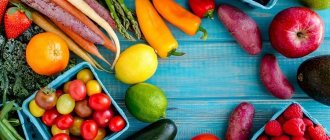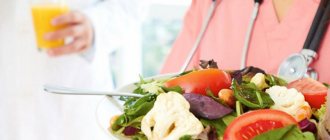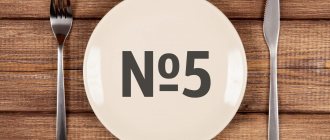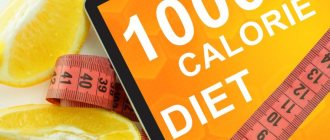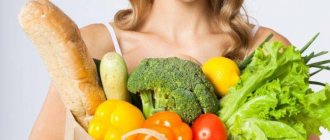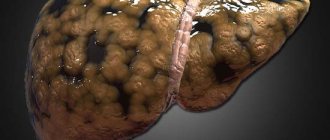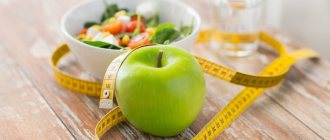Basic recommendations for dietary table No. 1
Most dishes in this diet are prepared:
- steamed;
- pureed;
- in boiled form.
In addition, it is important to consider the following important elements in nutrition:
- The minimum amount of food is served fried (necessarily without a crust). The use of salt and spices should be limited.
- Dishes such as fish or soft meats are served in one piece.
- When following this diet, it is advisable to adhere to the diet at least five to six times a day.
- Late dinner is best replaced with low-fat cream.
What can you eat?
When following a therapeutic diet, it is recommended to eat the following foods:
- Soups with lean broth;
- Slimy porridge with water or diluted milk;
- Dietary meat (turkey, rabbit, chicken fillet);
- Steamed or boiled vegetables;
- Herbal infusions or tea with added milk;
- Vegetable or olive oil;
- Various types of jelly (milk, fruit);
- Soft-boiled eggs or egg omelet;
- Lean fish (preferably oceanic);
- Bran decoction.
It is allowed to drink freshly squeezed juices diluted with water in equal proportions. You can use a small amount of butter as a dressing for dishes.
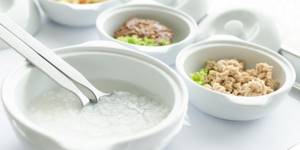
The main purpose of medical diet number 1
The goal of diet table No. 1 is considered to be a narrowing of the gastrointestinal tract in a gentle manner and at a moderate pace. That is why this diet, the menu and recipes of which are listed below, is used for peptic ulcers and diseases of the duodenum. Due to the narrowing of the patient's gastrointestinal tract:
- normalization of medical indicators in the motor and secretory functions of the stomach is achieved;
- inflammatory processes are reduced;
- ulcer healing occurs.
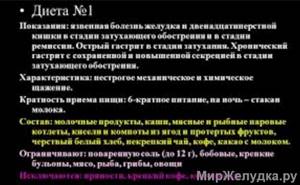
Diet according to Pevzner
Main menu
For therapeutic diet 1a according to Pevzner, vegetable-based soups with noodles, rice or just vegetables are perfect. The dressing can be cream or a boiled egg. Among the advantages, fish and some types of meat are allowed, but not rough ones.
If you follow dietary table number 1a, you will have to give up rye bread, replacing it with crackers or more dried baked goods. Completely exclude puff pastry, fatty meats and canned food, salty cheeses, marinades and hot sauces. For peace of mind, the ban also applies to white cabbage, mushrooms, spinach, sorrel, cucumbers, onions, black coffee, cocoa and carbonated drinks.

What can and cannot be eaten on diet table No. 1?
Lean meat
Increased attention is paid to meat products, which must be:
- soft;
- without hard skin;
- seedless.
A wonderful lunch recipe - chicken zrazy.
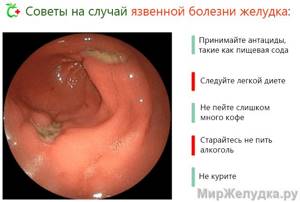
Adviсe
Flour and bread products
It is strictly prohibited to include bread made from rye flour, as well as puff pastry products, into your diet. For medicinal purposes, doctors advise reducing the consumption of flour products throughout the diet.
Dairy and fermented milk products
During the diet, you are allowed to consume a variety of dairy products:
- cream;
- low-fat cottage cheese;
- cheese.
It should be remembered that cheese should be added to your diet only once a week. An important feature is that the cheese must be a low-fat hard cheese.
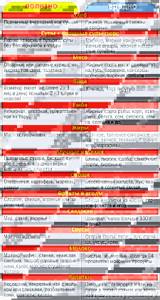
Food
Various vegetables, fruits
All types of vegetables are allowed, but it is important to remember to prepare them correctly. Vegetable dishes should only be served boiled. Also, diet table number 1 encourages the consumption of juicy fresh fruits.
What foods are good for the stomach?
Grocery list
The preparation of a diet for gastritis, stomach ulcers, duodenal ulcers, or 5-6 days after gastric surgery must be approached with great responsibility. It should contain easily digestible food with high nutritional value.
Allowed foods and dishes:
- Soups based on a slimy broth with the addition of cereals (semolina, rice, oatmeal). You can add milk, butter, beaten eggs and low-fat cream to soups.
- Lean meat (beef, rabbit, veal) and poultry. Before cooking, products are cleaned of thick and thin tendons and fat; if it is chicken or turkey meat, the skin is completely removed. To prepare meat puree or steam soufflé, cook the meat for a long time, beat it into a dense mass using a blender or grind it 2-3 times in a meat grinder.
- Lean sea fish (pike perch, hake, cod, pollock) without skin. Steam air soufflé or liquid puree soup is prepared from it.
- Dairy products in the form of whole milk, skim cream, soufflé made from cottage cheese pureed until smooth.
- Eggs. The daily norm is 3 soft-boiled eggs, a steam omelette made from them or an airy soufflé.

- Cereals ground in a blender or coffee grinder to prepare slimy porridges. You can have oatmeal, buckwheat, rice. Semolina is most often used to make pudding, mousse or sweet porridge.
- Drinks: fruit teas and jelly with minimal sugar content, rosehip decoction, bran decoction.
- Fats in the diet should come from butter and refined oils by adding them to ready-made dishes.
The ban includes foods that are difficult to digest, stimulate secretion, and irritate the mucous membrane and walls of the gastrointestinal tract. This:
- Flour products (especially hot ones);
- Corn, pearl barley and barley cereals;
- Fresh fruits;
- Vegetables in any form;
- Fermented milk products, cheeses and sour cream;
- Legumes (beans, lentils, peas);
- Sauces, ketchups and spices;
- Soups with meat broth;
- Marinades, pickles, canned food;
- Coffee, cocoa, soda.
Weekly menu at table No. 1
Monday
- Early morning (before 9 am) includes:
- a relatively small amount of vermicelli porridge;
- several pieces of low-fat and unsalted hard cheese.
- Breakfast – any baked fruit of your choice.
- Lunch – mashed potatoes, chicken cutlets and compote.
- Dinner – steamed omelette and apple pudding.
- Second dinner - warm milk.
Tuesday
- The first meal consists of boiled small pasta.
- Breakfast – carrot salad and tomato.
- Lunch – cabbage soup and a piece of beef with cherry juice.
- Dinner – buckwheat soup, carrot roll.
- Second dinner - cream and a mixture of dried fruits.

Wednesday
- The first meal is oatmeal and any fresh fruit.
- Breakfast – applesauce.
- Lunch – light fruit salad and tea.
- Dinner – potatoes with chicken bits and a glass of kefir.
- Second dinner - warm milk.
Thursday
- The first meal consists of milk porridge with noodles.
- Breakfast - one banana and a few pieces of cheese.
- Lunch – steamed chicken and compote.
- Dinner – puree, apricot juice.
- Second dinner - a glass of low-fat cream.
Friday
- The first meal is cottage cheese and oatmeal.
- Breakfast – chamomile tea and several breads.
- Lunch – buckwheat cutlets, green tea and some liver.
- Dinner – vermicelli soup, chamomile infusion.
- Late dinner - yogurt.
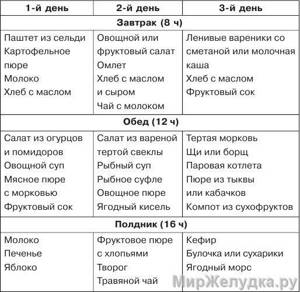
Saturday
- Early morning (7-8 hours) – fruit milkshake, steamed omelette.
- Breakfast – cottage cheese with berries.
- Lunch – a small piece of fish with green tea.
- Afternoon snack – apricot jelly.
- Dinner – rice broth and fruit salad.
- Second dinner - a glass of milk.
Sunday
- The first meal is buckwheat porridge and chamomile tea.
- Breakfast – boiled vegetables to your taste.
- Lunch – carrot juice, oatmeal soup and beef meatballs.
- Dinner - cheese pasta, a glass of kefir.
- Second dinner - any herbal solution of your choice.

Glutinous rice soup
Ingredients:
- rice – 50 grams;
- 1 chicken egg;
- low-fat milk – 200 ml;
- butter – 15 grams;
- water.
Cooking method:
- Cook the rice until completely cooked. Then filter through a fine sieve.
- Add 3 tablespoons of boiled rice to the rice broth and place on low heat.
- Mix the milk with the egg and add the mixture to the broth. Remove from heat after 1-2 minutes of cooking.
You can add grated boiled carrots and finely chopped greens to the finished dish. Serve with a piece of butter.
When is diet No. 1 according to Pevzner prescribed?
The diet is prescribed to patients with various gastrointestinal diseases:
- With peptic ulcer and chronic gastritis with medium and high degree of gastric secretion.
- Experts recommend this diet for severe diseases of the duodenum.
- With exacerbation of gastritis.
- Throughout the entire period of treatment of acute gastritis.
- During the postoperative recovery period.
Table No. 1 is included in the cycle of fifteen diets that were created and developed by the Soviet therapist and gastroenterologist M.I. Pevzner.
Project consultant, co-author of the article: Ovchinnikova Natalya Ivanovna | Gastroenterologist, Hepatologist, Infectious disease specialist 30 years of experience / Doctor of the highest category, Candidate of Medical Sciences
Education:
Diploma in General Medicine, Novosibirsk State Medical Institute (1988), Residency in Gastroenterology, Russian Medical Academy of Postgraduate Education (1997)
Semolina milk soup

Diet 1a, the weekly menu with recipes for which is quite balanced, recommends milk soup.
Ingredients:
- 4 teaspoons semolina;
- 1 glass of pasteurized milk;
- 1 glass of water;
- 1/3 teaspoon butter;
- 1 egg;
- 1/5 teaspoon sugar;
- salt.
Cooking method:
- Mix 2/3 of the milk with water and boil.
- Pour sifted semolina into a thin stream, stirring. Cook until fully cooked.
- Beat the egg with 1/3 of the hot milk. Add the egg-milk mixture to the soup and stir.
- Cook without bringing to a boil.
When serving, add a piece of butter.
Pumpkin baked in a pot with zucchini and cheese
Ingredients:
- 400-500 grams of pumpkin;
- half a zucchini;
- 100 grams of white beans;
- 200 grams of cheese;
- 2 tablespoons butter.
Cooking method:
- Boil white beans until half cooked in advance.
- Peel the pumpkin and zucchini from peels and seeds, cut into small cubes. Same with feta cheese.
- Preheat the oven to 200 degrees, then reduce to 180.
- First put pumpkin and zucchini, boiled beans and pieces of cheese into the pot. The top layer is pieces of butter.
- Cover the pot with foil and place in the oven to simmer for 25-30 minutes.
- Then turn off the oven and leave to simmer for 10 minutes.
Before serving, you can add a spoonful of sour cream.
Useful tips
The following is recommended:
- Maximum balanced diet. The approximate amount of calories is up to 3000, otherwise the body may suffer from exhaustion.
- Adhere to the principle of fractional nutrition, that is, eat in small portions (“palm”), dividing meals into 4–6 approaches.
- Accompanying diseases must be taken into account.
- Every day it is recommended to drink at least 1.5 liters of water, except for soups, compotes or juices.
- Everything fried, spicy and smoked is excluded from the diet.
Recipes for diet No. 1
Recipes for table No. 1 for ulcers and gastritis at first can be easily found on the Internet. It is best to look for them on thematic forums or groups, blogs. There, people with similar problems share recipes, reviews and recommendations.
Diet pate
This pate is suitable for diseases of ulcers, gastritis, and pancreatitis.
To prepare you need to cook:
- 100 g beef;
- 2 pcs. potatoes;
- 1 medium carrot.
All ingredients should be passed through a meat grinder. Pour half a glass of milk into the prepared minced meat, stirring occasionally, and simmer over low heat (3 minutes). The finished dish can be slightly salted.
Dietary baked cutlets
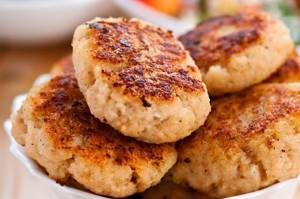
To prepare you will need:
- 2 tablespoons of cottage cheese (fat content up to 9%);
- 1 egg;
- 150 g beef;
- butter.
The meat needs to be boiled and cooled (it should be without tendons and fascia). Beef and cottage cheese should be minced twice. Beat the egg, leave a small part for greasing, pour the rest into the minced meat. Add oil there and mix well. Place the formed cutlets on a baking sheet and brush them with egg, bake them in the oven until cooked. If you steam the cutlets, they are suitable for table 1a.
Meringues
A universal dessert suitable for all family members. It is easy to prepare, it looks beautiful and, most importantly, it is very tasty.
To prepare meringues you will need:
- 3 squirrels;
- half a glass of sugar or powdered sugar.
The whites must be carefully separated from the yolks. It is important that the dishes are completely dry (without a drop of grease). Place the protein mass in a bowl, then place this bowl in a larger bowl with warm water. The heated proteins will produce a mass that is more dense and filled with air. Beat with a mixer at low speed. When the whites become cloudy, you can gradually add sugar or powder (half a teaspoon at a time) and increase the mixer speed. When the mass is completely dense, you can start drying.
If you don’t have a pastry bag, you can use a spoon or a simple bag and cut off the edge. Grease a baking tray or cover it with baking paper. Place the meringues in the oven at 700 degrees and leave to dry for 60 minutes. After this, turn off the oven and do not remove the dessert until it has cooled completely. Meringues can be used as a layer for a cake, as a decoration or as an independent dessert.
Boiled beef dumplings in broth
Ingredients:
- 300 grams of beef, deveined;
- half an onion;
- 1 egg;
- 2-3 slices of white wheat bread;
- 1 tablespoon butter;
- 1 tablespoon sour cream;
- a pinch of salt.
Cooking method:
- The beef is cut into small pieces.
- Half an onion is cut and stewed in butter until golden brown.
- Slices of bread are soaked in milk, squeezed and mixed with sour cream.
- All ingredients are passed through a meat grinder and mixed.
- Salt is added to the minced meat.
- Then they roll it into a sausage, wrap it in white cotton fabric and tie it with thread along the edges.
- Dip into salted boiling water and cook for 10-15 minutes.
Before serving, remove the “casing” from the meat, cut into pieces and place in a deep plate with broth. You can add boiled vegetables and herbs.
Steam omelette

Ingredients:
- 2 eggs;
- 1/2 cup milk;
- 1/5 teaspoon butter;
- salt.
Cooking method:
- Beat eggs and milk.
- Grease the mold with butter.
- Pour the egg-milk mixture into molds and steam.
For better baking, the thickness of the omelette should be no more than 4 cm. When serving, pour melted butter over it.
general description
Diet 1 for stomach ulcers is quite varied. The diet is formed so that parts of the gastrointestinal tract deformed as a result of the disease absorb an insignificant proportion of nutritional components. This menu makes it possible to quickly get rid of the feeling of hunger that provokes pain.
Approximate composition of the treatment table (in grams per day):
- proteins – 90–100, of which 65% are of animal origin;
- fats – 75–85, of which vegetable fats – at least 20%;
- carbohydrates – 350–400;
- salt - no more than 8.
A balanced diet will allow you to get up to 3 thousand calories daily, which is the norm. Do not forget that you need to drink at least 1.5 liters of liquid.
